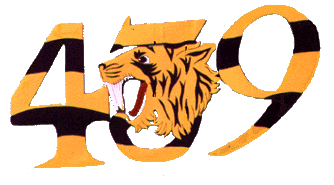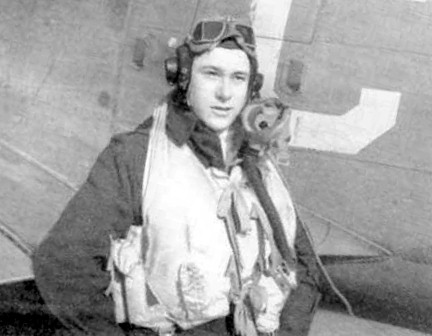|
History
of
 Squadron Squadron
  
Chapter
VII
The Advance to the Rhine
February
- March 1945
|
The one exeption was a sortie led by
F/L B.B.Swingler in the mid afternoon. After bombing the railroad at
.....ele, between Borken and Stadlohn, with unobserved results because of the poor visibility, the four pilots made an armed recce along the Rhide. Near Haldern Swingler noticed a solitary vehicle and after an exploratory orbit he led his section down to strafe. It wasevidently a flak trap, for when the Tiffies were at about 2000 feet
"all hell seemed to break
loose", filling the sky with 20 mm. flak.
Swingler never had a chance; his aircraft crashed into the ground.
"Babe" was one of the squadron's old originals who had completed one tour in November and, after a three months' rest, had just returned the previous day to start his second tour as "A" Flight commander in succession to John Carr. He was lost on his second trip.
|

Photo
439 Archives
|
Intentionally
left blank
|
Rail cutting was on the
program nine times on 24 February, and six times the mission was successfully completed. The first sortie was almost abortive when a sudden fog rolled over Eindhoven, causing the section to be recalled before it reached the target. On the way back the pilots jettisoned their bombs on the marshalling yard at Emmerich, causing a large explosion an done satisfying rail cut. The fog soon cleared from base and ops. resumed with three sections taking off, one after the other at 10 a.m. S/L Beatty
reported four cuts in the Rheine Lingen tracks, F/O Davis got two more just east of Rheine, and F/L Shaver tallied a splendid six on the Rheine Hengelo line.
It will be noticed that the squadron was extending its activities farther north. In their usual area between
Winterswijk, Coesfeld, Dorsten and Geldern, the pilots later in the day made three rail cuts near Borken and two more south west of
Winterswijk. In another attack west of Dorsten a road crossing the railway was cratered and a switch house was destroyed. Cloud was quite a handicap on most of the sorties and one formation of two sections, led by F/Os Bill Davis and Jack Roberts, had to find alternative targets. Near Zutphen
(1)
they bombed two bridges across the Twente canal, damaging one and cutting a road by the other.
|
|
Results on the 25th were less satisfying as cloud intervened on the last three of the day's operations, obscuring results on one attack and rendering the other two sorties abortive. Earlier in the day, however, three good
rail jobs had been completed, resulting in one cut between Zutphen and
Ruurlo, four (by S/L Beatty's section) between Deventer and
Rijssen; and one more near Dulmen in Germany. On these three missions the aircraft carried 500 lb. bombs
(2)
for the first time in a month.
(1) The sortie report says "between Zutphen and
Ruurlo" but gives a pinpoint to the north of the other line.
(2) The heavy expenditure of 1000 lb. bombs had resulted in a temporary shortage of this type. When the pilots returned to the 500 lb. missiles, they discovered they had to adopt a decidedly different technique, particularly when there was a high wind which caused greater drift. On the whole they believed a shallower dive was more
successful with the lighter bombs.
Between the first
successful group of three attacks and the final unsuccessful triad, No.439 had participated in another wing operation against the Puttershoek flying bomb site. The procedure was similar to that followed on the 2.. No.137
Sqn. of 124 Wing rocketed one group of flakposts, No.438 plastered another with anti
personnel bombs, and No.439 en 440 these went in on the buzz bomb position, the former raking the ramp and the latter the warehouse. The anti flak squadrons did their work so well
that no defence fire was seen. The bombers likewise did a good job,
covering the target with strikes, explosions and fires. Haze made it difficult to determine specific results other than two direct hits on a warehouse.
  
Copyright
©1998-2016 Michael T. Melnick. All rights reserved
the
unofficial homepage of  Tiger
Squadron Tiger
Squadron
.
.
|
|